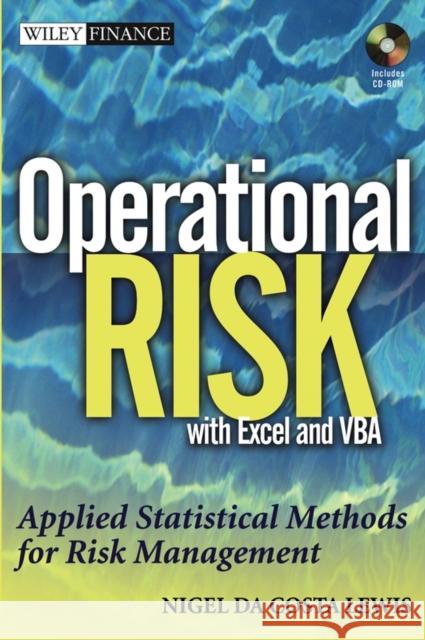Operational Risk with Excel and VBA: Applied Statistical Methods for Risk Management, + Website » książka



Operational Risk with Excel and VBA: Applied Statistical Methods for Risk Management, + Website
ISBN-13: 9780471478874 / Angielski / Twarda / 2004 / 288 str.
Operational Risk with Excel and VBA: Applied Statistical Methods for Risk Management, + Website
ISBN-13: 9780471478874 / Angielski / Twarda / 2004 / 288 str.
(netto: 379,50 VAT: 5%)
Najniższa cena z 30 dni: 385,99 zł
ok. 22 dni roboczych.
Darmowa dostawa!
A valuable reference for understanding operational risk Operational Risk with Excel and VBA is a practical guide that only discusses statistical methods that have been shown to work in an operational risk management context. It brings together a wide variety of statistical methods and models that have proven their worth, and contains a concise treatment of the topic. This book provides readers with clear explanations, relevant information, and comprehensive examples of statistical methods for operational risk management in the real world. Nigel Da Costa Lewis (Stamford, CT) is president and CEO of StatMetrics, a quantitative research boutique. He received his PhD from Cambridge University.
Wydanie ilustrowane
Preface.
Acknowledgments.
CHAPTER 1: Introduction to Operational Risk Management and Modeling.
What is Operational Risk?
The Regulatory Environment.
Why a Statistical Approach to Operational Risk Management?
Summary.
Review Questions.
Further Reading.
CHAPTER 2: Random Variables, Risk indicators, and Probability.
Random Variables and Operational Risk Indicators.
Types of Random Variable.
Probability.
Frequency and Subjective Probability.
Probability Functions.
Case Studies.
Case Study 2.1: Downtown Investment Bank.
Case Study 2.2: Mr. Mondey s OPVaR.
Case Study 2.3: Risk in Software Development.
Useful Excel Functions.
Summary.
Review Questions.
Further Reading.
CHAPTER 3: Expectation, Covariance, Variance, and Correlation.
Expected Value of a RandomVariable.
Variance and Standard Deviation.
Covariance and Correlation.
Some Rules for Correlation, Variance, and Covariance.
Case Studies.
Case Study 3.1: Expected Time to Complete a Complex Transaction.
Case Study 3.2: Operational Cost of System Down Time.
Summary.
Review Questions.
Further Reading.
CHAPTER 4: Modeling Central Tendency and Variability of Operational Risk Indicators.
Empirical Measures of Central Tendency.
Measures of Variability.
Case Studies.
Case Study 4.1: Approximating Business Risk.
Excel Functions.
Summary.
Review Questions.
Further Reading.
CHAPTER 5: Measuring Skew and Fat Tails of Operational Risk Indicators.
Measuring Skew.
Measuring Fat Tails.
Review of Excel and VBA Functions for Skew and Fat Tails.
Summary.
Review Questions.
Further Reading.
CHAPTER 6: Statistical Testing of Operational Risk Parameters.
Objective and Language of Statistical Hypothesis Testing.
Steps Involved In Conducting a Hypothesis Test.
Confidence Intervals.
Case Study 6.1: Stephan s Mistake.
Excel Functions for Hypothesis Testing.
Summary.
Review Questions.
Further Reading.
CHAPTER 7: Severity of Loss Probability Models.
Normal Distribution.
Estimation of Parameters.
Beta Distribution.
Erlang Distribution.
Exponential Distribution.
Gamma Distribution.
Lognormal Distribution.
Pareto Distribution.
Weibull Distribution.
Other Probability Distributions.
What Distribution Best Fits My Severity of Loss Data?
Case Study 7.1: Modeling Severity of Loss Legal Liability Losses.
Summary.
Review Questions.
Further Reading.
CHAPTER 8: Frequency of Loss Probability Models.
Popular Frequency of Loss Probability Models.
Other Frequency of Loss Distributions.
Chi–Squared Goodness of Fit Test.
Case Study 8.1: Key Personnel Risk.
Summary.
Review Questions.
Further Reading.
CHAPTER 9: Modeling Aggregate Loss Distributions.
Aggregating Severity of Loss and Frequency of Loss Distributions.
Calculating OpVaR.
Coherent Risk Measures.
Summary.
Review Questions.
Further Reading.
CHAPTER 10: The Law of Significant Digits and Fraud Risk Identification.
The Law of Significant Digits.
Benford s Law in Finance.
Case Study 10.1: Analysis of Trader s Profit and Loss Using Benford s Law.
A Step Towards Better Statistical Methods of Fraud Detection.
Summary.
Review Questions.
Further Reading.
CHAPTER 11: Correlation and Dependence.
Measuring Correlation.
Dependence.
Stochastic Dependence.
Summary.
Review Questions.
Further Reading.
CHAPTER 12: Linear Regression in Operational Risk Management.
The Simple Linear Regression Model.
Multiple Regression.
Prediction.
Polynomial and Other Types of Regression.
Multivariate Multiple Regression.
Regime–Switching Regression.
The Difference Between Correlation and Regression.
A Strategy for Regression Model Building in Operational Risk Management.
Summary.
Review Questions.
Further Reading.
CHAPTER 13: Logistic Regression in Operational Risk Management.
Binary Logistic Regression.
Bivariate Logistic Regression.
Case Study 13.1: Nostro Breaks and Volume in a Bivariate Logistic Regression.
Other Approaches for Modeling Bivariate Binary Endpoints.
Summary.
Review Questions.
Further Reading.
CHAPTER 14: Mixed Dependent Variable Modeling.
A Model for Mixed Dependent Variables.
Working Assumption of Independence.
Understanding the Benefits of Using a WAI.
Case Study 14.1: Modeling Failure in Compliance.
Summary.
Review Questions.
Further Reading.
CHAPTER 15: Validating Operational Risk Proxies Using Surrogate Endpoints.
The Need for Surrogate Endpoints in OR Modeling.
The Prentice Criterion.
Limitations of the Prentice Criterion.
The Real Value Added of Using Surrogate Variables.
Validation Via the Proportion Explained.
Limitations of Surrogate Modelling in Operational Risk Management.
Case Study 15.1: Legal Experience as a Surrogate Endpoint for Legal Costs for a Business Unit.
Summary.
Review Questions.
Further Reading.
CHAPTER 16: Introduction to Extreme Value Theory.
Fisher–Tippet Gnedenko Theorem.
Method of Block Maxima.
Peaks over Threshold Modeling.
Summary.
Review Questions.
Further Reading.
CHAPTER 17: Managing Operational Risk with Bayesian Belief Networks.
What is a Bayesian Belief Network?
Case Study 17.1: A BBN Model for Software Product Risk.
Creating a BBN–Based Simulation.
Assessing the Impact of Different Managerial Strategies.
Perceived Benefits of Bayesian Belief Network Modeling.
Common Myths About BBNs The Truth for Operational Risk Management.
Summary.
Review Questions.
Further Reading.
CHAPTER 18: Epilogue.
Winning the Operational Risk Argument.
Final Tips on Applied Operational Risk Modeling.
Further Reading.
Appendix.
Statistical Tables.
Cumulative Distribution Function of the Standard Normal Distribution.
Chi–Squared Distribution.
Student s t Distribution.
F Distribution.
Notes.
Bibliography.
About the CD–ROM.
Index.
NIGEL DA COSTA LEWIS, PHD, is the President of the quantitative research boutique StatMetrics, offering cutting edge quantitative solutions to a sophisticated institutional client base. Dr. Lewis has many years work experience as a quantitative analyst and statistician in London, on Wall Street, and in academia. His work in quantitative risk management dates back to the early 1990s, when he developed stress–testing methodologies for portfolios of derivative securities for Legal & General Investments. He is the author of a number of books on risk management and quantitative methods and a regular speaker at international conferences. His current research work specializes in the application of computational–intensive quantitative methods to problems in risk management. He received a PhD in statistics from the University of Cambridge, and master s degrees in statistics, finance, economics, and computer science, all from the University of London.
Praise For Operational Risk with Excel and VBA
"Dr. Nigel Da Costa Lewis has produced the most exciting volume ever on operational risk modeling. It is a must for students, practitioners, risk managers, and senior executives. . . I feel this work is the first step in revolutionizing the discipline. Other books in this field tell you in theory, there is little difference between theory and practice. Dr. Lewis s work tells you what we all know, in practice, there is."
Dr. O.F. Agbaje, School of Informatics, City University, London
"Dr. Nigel Da Costa Lewis has raised the bar for books on operational risk. His book provides a bridge from the theoretical to the practical, and clears the fog between the buzzwords of operational risk management and the realities of useful modeling tools. The inclusion of numerous concrete examples and solutions will make a broad range of modeling techniques accessible to students of management science. Without a doubt, Dr. Lewis has put quality meat on the bare bones of this important management discipline. He is to be applauded for this magnificent effort."
Prof. Bernard Beecher, Department of Mathematics, City University, New York
"Dr. Nigel Da Costa Lewis has produced one of the most exciting and classic reference volumes on operational risk. As only great teachers can, Dr. Lewis makes even the most obtuse mathematics seem easy and intuitive . . . This book is a must for students, practitioners, and anybody interested in this important subject. In short, it is the most comprehensive and up–to–date textbook on operational risk modeling that I have seen."
Dr. Terence Yiu Wa Chow, Department of Mathematics, University College London, University of London
1997-2025 DolnySlask.com Agencja Internetowa
KrainaKsiazek.PL - Księgarnia Internetowa









